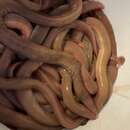Diagnostic Description
provided by Fishbase
Jawless mouth, single nasal aperture, only a single pair of external gill openings, no operculum or covering fold of skin. Grayish or reddish brown above, either plain. Variations in color correspond to the color of the sea bottom.
- Recorder
- Arlene G. Sampang-Reyes
Life Cycle
provided by Fishbase
Copulatory organ absent. The gonads of hagfishes are situated in the peritoneal cavity. The ovary is found in the anterior portion of the gonad, and the testis is found in the posterior part. The animal becomes female if the cranial part of the gonad develops or male if the caudal part undergoes differentiation. If none develops, then the animal becomes sterile. If both anterior and posterior parts develop, then the animal becomes a functional hermaphrodite. However, hermaphroditism being characterised as functional needs to be validated by more reproduction studies (Ref. 51361 ). Probably breed throughout the year in deep water (Ref. 35388).
Trophic Strategy
provided by Fishbase
Found on soft, muddy bottoms; requires high salinity (at least 30 ppt) and low temperature (below 12°C), conditions usually found in deeper waters (Ref. 5951). Feeds chiefly on dead and dying fish of varying species by boring into the body and consuming viscera and musculature. Food includes marine invertebrates such as polychaete worms and crustaceans (shrimp, Pandalus borealis, an important food item) (Ref. 5951), hermit crabs, limpets, nemerteans, priapulid worms and fishes (Ref. 117245). Chiefly nocturnal.
- Recorder
- Drina Sta. Iglesia
Biology
provided by Fishbase
Benthic with reported depths to 782 off Greenland; 960 m in Northwestern Atlantic; and 1,100 m off Norway (Ref. 119696). Found on muddy bottoms where they hide in the mud. Slime is used for defense. Feeds chiefly on dead and dying fish of varying species by boring into the body and consuming viscera and musculature. Chiefly nocturnal. Its eggs are few in number about 19-30 and large (20-25 mm), the horny shell has a cluster of anchor-tipped filaments at each end.
Importance
provided by Fishbase
fisheries: of no interest
Myxine glutinosa
provided by wikipedia EN
Myxine glutinosa, known as the Atlantic hagfish in North America, and often simply as the hagfish in Europe, is a species of jawless fish of the genus Myxine.
Distribution
The distribution of Myxine glutinosa in the eastern Atlantic Ocean extends from the western Mediterranean Sea and Portugal to the North Sea, Skagerrak, Kattegat and the Varanger Fjord.[3] It is also found in the western Atlantic Ocean from Baffin Island, Canada south to North Carolina.[4] A related species, the Gulf hagfish (Eptatretus springeri), occurs in the Gulf of Mexico.[5]
Description
The Atlantic hagfish may grow up to 2.5 feet (0.76 m) long, with no eyes and no jaws; its star-shaped mouth is surrounded by 6 barbels.[4] There is a single gill slit on each side of the eel-like body.[4] It has a total of 88–102 pores from which it can exude a slimy mucus.[3] Hagfish have very flexible bodies which allow them to manipulate themselves into knots. The knots created by the hagfish remove mucous from the body, allow them to escape tight spaces, pull potential prey from burrows, and because they have no opposable jaws it helps create leverage while they eat.[6]
Ecology
Hagfish such as M. glutinosa feed on the carcasses of fishes, which they bore into through any available opening.[3][4]
References
-
^ Froese, R.; Pauly, D. (2017). "Myxinidae". FishBase version (02/2017). Retrieved 18 May 2017.
-
^ Van Der Laan, Richard; Eschmeyer, William N.; Fricke, Ronald (11 November 2014). "Family-group names of Recent fishes". Zootaxa. 3882 (1): 1–230. doi:10.11646/zootaxa.3882.1.1. PMID 25543675.
-
^ a b c P. J. P. Whitehead; M.-L. Bauchot; J.-C. Hureau; J. Nielsen; E. Tortonese, eds. (1986) [1984]. "Hagfish (Myxine glutinosa)". Fishes of the NE Atlantic and the Mediterranean.
-
^ a b c d Michael Filisky & Roger Tory Peterson (1998). "Atlantic Hagfish". Peterson First Guide to Fishes of North America (2nd ed.). Houghton Mifflin Harcourt. p. 10. ISBN 978-0-395-91179-2.
-
^ Edwin S. Iversen & Renate H. Skinner (2006). "Atlantic hagfish Myxine glutinosa". Dangerous Sea Life of the West Atlantic, Caribbean, and Gulf of Mexico: A Guide for Accident Prevention and First Aid. Pineapple Press. p. 72. ISBN 978-1-56164-370-7.
-
^ Haney, W. A., Clark, A. J., & Uyeno, T. A. (2019). Characterization of body knotting behavior used for escape in a diversity of hagfishes. Journal of Zoology. doi: 10.1111/jzo.12752
Haney, W. A., Clark, A. J., & Uyeno, T. A. (2019). Characterization of body knotting behavior used for escape in a diversity of hagfishes. Journal of Zoology. doi: 10.1111/jzo.12752

- license
- cc-by-sa-3.0
- copyright
- Wikipedia authors and editors
Myxine glutinosa: Brief Summary
provided by wikipedia EN
Myxine glutinosa, known as the Atlantic hagfish in North America, and often simply as the hagfish in Europe, is a species of jawless fish of the genus Myxine.
- license
- cc-by-sa-3.0
- copyright
- Wikipedia authors and editors
Diet
provided by World Register of Marine Species
Dead and dying fishes and invertebrates
North-West Atlantic Ocean species (NWARMS)
- license
- cc-by-4.0
- copyright
- WoRMS Editorial Board
Distribution
provided by World Register of Marine Species
Western Atlantic from Greenland to New York
North-West Atlantic Ocean species (NWARMS)
- license
- cc-by-4.0
- copyright
- WoRMS Editorial Board
Habitat
provided by World Register of Marine Species
Found at depths of 40- 1200m over muddy bottoms.
North-West Atlantic Ocean species (NWARMS)
- license
- cc-by-4.0
- copyright
- WoRMS Editorial Board
Habitat
provided by World Register of Marine Species
benthic
North-West Atlantic Ocean species (NWARMS)
- license
- cc-by-4.0
- copyright
- WoRMS Editorial Board

